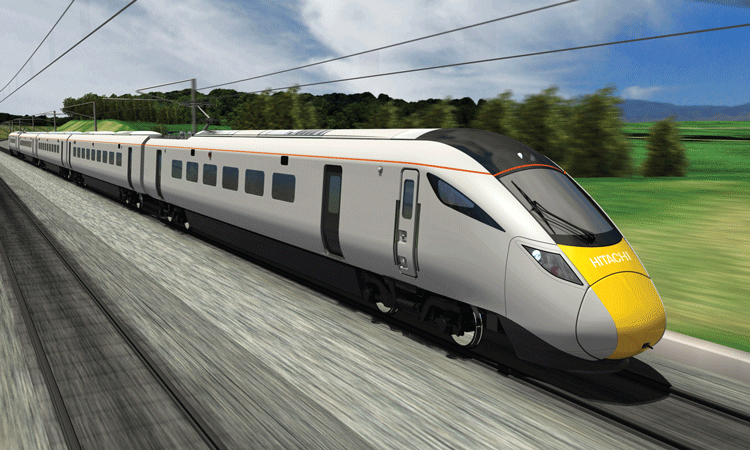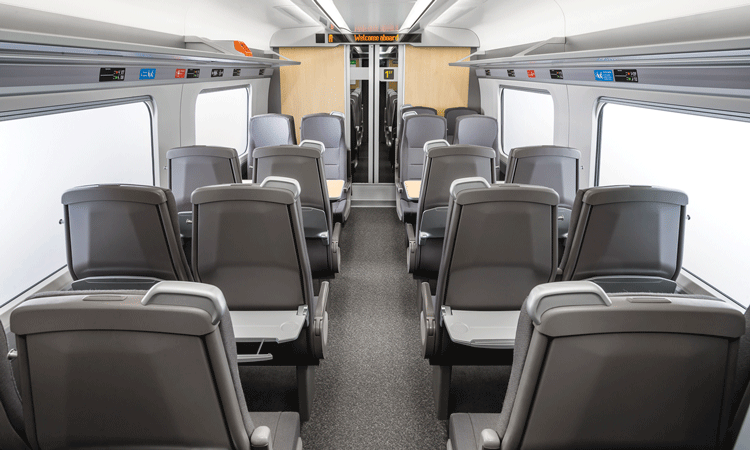Next generation of trains for the Intercity Express Programme
Posted: 20 July 2014 | Stephen Hammond | No comments yet
Thanks to privatisation, the UK’s railways are a huge success story with more people than ever using the rail network. Over the last year, there was a 5.7% increase in passenger journeys to 1.6 billion. While this increase is welcome it brings with it challenges. Stephen Hammond – the UK’s Parliamentary Under Secretary of State for Transport – writes to show how determined he is that all involved will rise to the occasion and build a world-class railway that can meet the demand.


Credit: Hitachi
Over the next five years, we are investing £38 billion in the biggest programme of rail modernisation since Victorian times. The Intercity Express Programme (IEP) is a key project in this programme, allowing us to make the most of this upgraded infrastructure and run more modern, reliable and higher-capacity trains between our great cities. In turn, this will help to support the UK’s long-term economic growth.
A truly exciting programme
This is a truly exciting programme which, through a combination of new rolling stock, infrastructure improvements, electrification and franchise changes, will revolutionise travel on the Great Western and East Coast Main Lines for millions of passengers.
The rolling stock element of the programme will see the existing high-speed trains and Class 225 fleets replaced with purpose-built Class 800/801 trains. Although the high-speed trains are iconic, they are also nearly 40 years old, and the modifications they would need to meet accessibility and environmental requirements – not to mention the maintenance they require – mean the time is right for replacement. The Class 225 fleet, while younger, is in similar need of significant refurbishment work. Once this is complete, that fleet will be used on other routes so that even more passengers can benefit from the upgrades in infrastructure.
Faster
The new IEP trains accelerate faster and have a higher top speed than the current trains, allowing more efficient use of paths on congested sections. They also have more seats – 19% more on a nine-car Class 800/801 compared to a Class 225. These two benefits add-up to 28% more seats into Kings Cross over the morning peak and 40% more into Paddington. These increases are separate from the other major projects of Crossrail and Thameslink, which will also provide many more seats into and through London.
A full-scale mock-up of the new train has been created by DCA, an award-winning British design firm in Warwick. On a recent visit I was able to walk through the train, ask questions and comment on all aspects of the design. The Secretary of State has also visited along with Passenger Focus, the British Transport Police, Sustrans, the Scottish and Welsh administrations and representative passenger groups. In total, DCA estimate that more than 2,000 people have visited the mock-up and provided feedback.
This inclusive process has resulted in an amazing train design. Passengers will have seats with legroom and space that is best-in-class, with standard class better than some other operators’ first class. There will be more luggage capacity, with much more space in the saloon and areas at the end of vehicles capable of holding bikes and other bulky items. We estimate that on a five-car train there is as much luggage space as on a high-speed train.
Addressing the needs of passengers to stay connected
We have also taken into account the needs of passengers to stay connected, with the internal Ethernet network using the latest generation Cat 7 10 Gigabit cables. This will allow the operators to fit Wi-Fi equipment that can deliver fast connections to everyone on-board. The windows have also been specially designed to reduce interference with mobile phone signals. The design doesn’t just rely on modern-technology though; in the seat-back tables there is a little slot for a tablet computer. This small example represents the immense amount of attention to detail that has gone into the design to make the experience for the passenger the best it can be.


Passengers will have seats with legroom and space that is best-in-class. Credit: Hitachi
The trains will be built in Hitachi’s brand new factory in Newton Aycliffe, County Durham, where we have just provided a £4 million grant to support its construction. This factory will employ 730 people when operational and an additional 400 during the build phase. Hitachi are keen to use this £82 million facility as a base to build their manufacturing base and expand into the European markets.
Employing the supply chain
Hitachi’s factory is not just good news for the 730 people employed there. It’s also good for potentially thousands more employed in the supply chain. Hitachi have an excellent reputation for using local suppliers where possible and have assured me that this will continue. Many of the materials for the factory will be sourced from within 50 miles of the site, and many of the components for the trains will be sourced from the North East and across the UK. Hitachi have signed, or expect to sign, contracts with North East companies such as Petards, Nomad Digital and Romag.
When the first trains start to run on the network from 2017, one of our key aims is for passengers to benefit from improved reliability and, from the outset, we are building this requirement into the rolling stock agreement. Under the contract we have signed with Agility Trains (a consortium of Hitachi Rail Europe and John Laing), Agility are responsible for the design, build, finance and maintenance of the rolling stock and maintenance facilities required to deliver the IEP over a 27-and-a-half-year term. Hitachi Rail Europe are designing and constructing the trains, and will, as part of Agility, be responsible for the maintenance of the fleets once they are introduced into service.
The deal for both fleets is worth £5.7 billon over the duration of the contract, split £3 billion for the Great Western fleet and £2.7 billion for the East Coast. The return for Agility will be through payments from the operator, based on the number of trains they deliver on-time, clean and ready for service each morning. There are penalties for lack of availability or reliability failures during the day. This incentivises Hitachi as designer, manufacturer and maintainer to design a train that will be around three times more reliable than the current fleet. It’s important that the passenger sees real benefits from our investment and I am confident that they will notice the increased comfort and enhanced reliability on their journeys with fewer delays caused by rolling stock faults.
Better connectivity
Better connectivity is another aim. On the Great Western Main Line, the routes served by the new trains include Paddington to Bristol, Cardiff and Swansea, Oxford and Herford and Cheltenham Spa as well as other occasional destinations, and a new timetable, will take advantage of the electrification of the route with all destinations better served. For instance, passengers will see a doubling of services to Bristol, with the new route via Bristol Parkway taking up to 15 minutes less than the traditional route via Bath.
Communities on the East Coast Main Line, including London to Leeds, York, Newcastle and Edinburgh, will also see an increase in services with the whole East Coast fleet being replaced. The new timetable for the East Coast Main Line is currently being developed by the current bidders for the Intercity East Coast Franchise and the benefits of the IEP will be delivered by the successful bidder. We are confident that the benefits of competition will drive improvements to services including frequency and journey times. In addition, the bi-mode capability of Class 800s will allow new destinations off the wires to be served while retaining the enhanced performance of electric rolling stock under the wires.
To prepare these two routes, we have committed £180 million for the Great Western and £330 million for the East Coast Main Line under Network Rail’s Control Period 5 to invest in gauge clearance and platform lengthening – both for the benefit of the new trains and for other rolling stock.
On both routes the roll-out of ERTMS was something else we needed to take into account, and both fleets will be fitted with the system as standard. This is not the only upgrade option that we have taken up. As part of the negotiations for the second part of the East Coast fleet, Agility Trains offered to upgrade the design to allow the trains to be capable of running in passenger service at 140mph (225kph). To ensure that the benefits of this enhanced speed can be realised, my officials are working with Network Rail on a feasibility study to identify opportunities to reduce journey times further.
The Intercity Express Programme represents a step change in intercity services on the Great Western and East Coast Main Lines. This next generation of trains will travel through the birthplace of the railways and along the famous Great Western designed and built by Isambard Kingdom Brunel. The pioneers had great ambition for their railway – the Intercity Express Programme is a statement of our ambition for the 21st century.


Issue
Related topics
European Rail Traffic Management System (ERTMS), Passenger Experience/Satisfaction, Rolling Stock Orders/Developments
Related organisations
British Transport Police (BTP), Crossrail Ltd, Hitachi Rail, Passenger Focus, Thameslink







